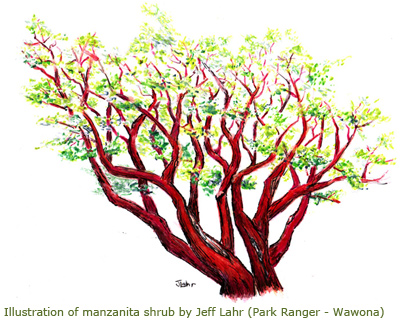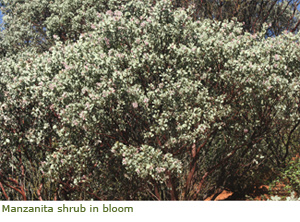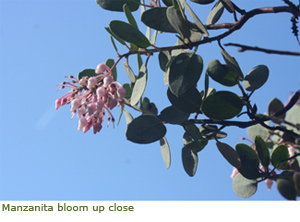 The manzanita is a dramatic looking shrub that brings a splash of color to its surroundings. The twisting bright red wood of the manzanita's trunk beautifully contrasts with its light green gray leaves. Depending on the season, closer examination may reveal either its delicate flower or the berry.
The manzanita is a dramatic looking shrub that brings a splash of color to its surroundings. The twisting bright red wood of the manzanita's trunk beautifully contrasts with its light green gray leaves. Depending on the season, closer examination may reveal either its delicate flower or the berry.
Although closely associated with the lower elevation chaparral ecosystem, species of manzanita can be found in many dry and exposed landscapes at elevations up to 10,000 feet. Chaparral areas where the manzanita is most frequently found is a region impacted by the Mediterranean climate of California, characterized by relatively mild and wet winters and very hot and dry summers. Because of its environment the manzanita has adapted to both drought and fire.
The hot, dry summers mean the manzanita must survive in extreme conditions. Due to summer drought, manzanita have a short growing season in the spring when water is most available. Developing a system of fine roots, the Manzanita can out-compete the pine trees and other conifers that might otherwise encroach upon the bare unshaded soil where the manzanita thrives. During the dry, summer months the plant becomes nearly dormant. Like several other chaparral plants, the manzanita has a specialized leaf that is well adapted to dry summers. The hard, leathery, evergreen foliage helps to prevent moisture loss.
The plant is also well adapted to the impact of fire. Fire can benefit the chaparral community by eliminating the pines that compete for the areas that support manzanita and other chaparral plants. Some species of manzanita are able to sprout after a fire from underground woody plant structures called lignotubers, basal burls, or root-crown burls. Furthermore, the extreme tough coated seed which can remain viable for over a hundred years needs fire or some other agent to weaken the seed coat to allow the seed to sprout.
The name "manzanita" is derived from the Spanish word meaning "little apple" in reference to the berry which appears on the tree in late summer. The berries have traditionally been used by indigenous people as a food source. Many animals such as bears, birds, and rodents also eat the manzanita berry and unwittingly assist in seed dispersal after the berry has been eaten and digested.
As you explore the lower elevations of Yosemite try to identify the manzanita. You will be rewarded by the beauty of its shiny red bark, and perhaps its delicate bell-shaped flowers or "little apple" berries.


